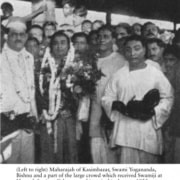India is the epitome of the world in everything — a land of all kinds of climates, religions, commerce, arts, peoples, scenery, stages of civilization, and languages.
Her civilization dates back many thousands of years. Her great seers, prophets, and rulers left records behind them that prove the great antiquity of the Aryan civilization in India.
Many European travelers visit India, see a few of the street magicians, sword-swallowers, or snake-charmers, and think that is the highest culture India has to offer them. They do not realize that these men do not represent India. The real life and secret of India’s vitality is her spiritual culture, which has made her the motherland of religions since time immemorial.
Although the West can teach India much about sanitation, business methods, and development of resources, and although India needs business missionaries like Henry Ford and Thomas Edison, yet the Western lands, too, are thirsty, consciously or unconsciously, for the practical spiritual lessons that India has specialized in for centuries..
In the Western cities, science has progressed so far that the physical man is usually well taken care of, fed and clothed and sheltered. Yet physical and material comfort without mental and spiritual peace and solace is not enough. India has been the unproclaimed reformer, the grand inspirer of human minds and souls. She has been the spiritual model of all religions. Her greatest and richest legacy to mankind has been the technique discovered and handed down for centuries by her saints and seers for the scientific spiritual culture of man.
India is a land of mystery, but of mystery that reveals itself to the sympathetic inquirer and seeker. India has the grandest and highest mountains — the Himalayas — in the world. Darjeeling, in the north of India, is the Switzerland of that country. The unique ruins of ancient castles and vast palaces of princes in Delhi; the vast Ganges, made sacred by the centuries of meditation near its banks by many God-realized saints; the sun-gilded teeth of the Himalaya mountain ridges; the ancient places and caves of meditation where Yogis and Swamis saw the faggots of ignorance blaze with the wisdom of God; the Taj Mahal at Agra, the finest dream of architecture ever materialized in marble to symbolize the ideal of human love; the dark forests and jungles where the distant tigers roam; the blueness of the Indian skies and the bright sunshine; the innumerable varieties of Oriental fruits and vegetables; the various types of people — all these tend to make India different, fascinating, romantic, never-to-be-forgotten.
A Land of Great Contrasts
India is a land of great contrasts — untold riches and utmost poverty, the highest mental purity and coarse, plain living, Rolls Royces and bullock carts, gaily-caparisoned elephants and quaint horse-wagons.
In the north, we find blue-eyed and blonde-haired Hindus, and in the hotter south we find the dark, sun-kissed skins of the tropics. From start to finish, India is a land of surprises, of contrasts and extremes. Life becomes prosaic with too much business, too many dull certainties; so in India one feels that life is a great adventure, a thing of mystery and surprise.
India may not have material skyscrapers and all the sometimes spiritually-enervating comforts of modern life. She has her faults, as all nations have, but India shelters many unassuming, Christ-like spiritual “skyscrapers” who could teach the Western brothers and sisters how to get the fullest spiritual joy out of any condition of life. Those scientific mystics and seers who have known Truth by their own effort and experience, and not through ordinary, unverified beliefs, can show others how to develop their own intuition and open the fountain of peace and satisfaction from beneath the soil of mysteries.
Though I have had the advantage of some western education, yet I feel that in India alone I found the true solution to the mysteries of life.
— November 1935
